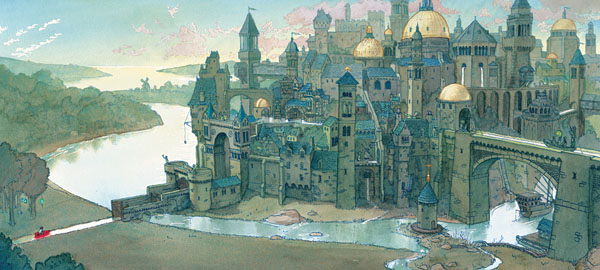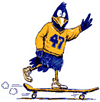
Copyright © 2013 by Aaron Becker. Reproduced by permission of the publisher, Candlewick Press, Somerville, MA.
As a boy growing up in Baltimore, Aaron Becker ’96 knew a trick: when he drew pictures, he became all-powerful. “Drawing was a way of making sense of what life was about,” Becker says, “On a piece of paper I could make all the rules that I wanted to.”
This year, with the release of his debut children’s book, Journey, Becker has created a world that invites its audience to follow the spirit of that child of years ago. Journey features a girl who uses a magical pen to slip from her distracted family to a rich world of her own timbre. With not a single word of text, Journey unfolds over 40 pages of captivating illustrations, detailed but not busy.
The book has won widespread positive notice. Amazon included it among its “Best Books” for young readers in summer 2013 while the New York Times called it a “masterwork.” School Library Journal placed the book on its list of contenders for the Caldecott Medal, the most notable award for picture books.
Comparisons to the 1955 classic Harold and the Purple Crayon have been numerous. People Magazine, for example, called Becker’s work “a descendant” of the earlier book. But Becker says that it was not until he completed Journey that he sat down with a copy of its predecessor—and was startled by the similarities. After mentioning a few of the plot parallels, he jokes, “Obviously I read the book when I was 3 and it entered my subconscious.” Becker feels he owes a greater debt to someone like Bill Watterson, creator of the popular comic Calvin and Hobbes, both for the quality of Watterson’s art and for his ability to authentically evoke childhood.
Becker eyed the possibility of writing a children’s book for years, but his path toward the goal was indirect. “I never had an art class,” he says of his K-12 education. He did briefly try one out in sixth grade, but found the approach was rote. Having drifted away in his teens from his artistic interests, Becker arrived at Pomona with a plan to study the Japanese language and Pacific Rim politics. When that desire dimmed, he considered designing his own major before settling on media studies, a newly offered concentration. His
coursework led him to renew his interest in the visual arts.
After Pomona, Becker settled in the San Francisco Bay Area with a job in web design. Still, he felt unready to sink into a desk job for the long haul. He left his position to travel and work with kids as a camp counselor. Next he decided on a further leap of faith: he would invest in classes at the Art Center College of Design in Pasadena, Calif., a move that paid off when it led to a job as a concept designer in the film industry. His work on such films as The Polar Express and Cars offered him artistic challenges and the opportunity to design for a children’s audience.
The moniker “kid at heart” is an apt one for Becker, who describes himself as a happy-go-lucky child who became a young man determined not to take life too seriously. Friend Aaron Rhodes PI ’97 says, “Aaron’s always had a playful side, and a very creative, active imagination. He’s never lost the ability to connect with his inner child.”
Becker has never been one to let life grow too routine. He and wife Darci Palmquist ’96 moved from California to the town of Amherst, Mass., in their mid-30s with plans to buy a house and start a family while telecommuting to their jobs back on the West Coast. When his company folded, Becker found himself the father of an infant daughter, living where he wanted to be—but with no job. That’s when he turned to children’s literature. It was a natural fit.
“Children are not jaded,” he says. “I’m not a jaded person. I don’t like cynicism.” He goes on: “I get that part of being a human being, when you’re young. The world can be scary, and it can be adventurous, but it’s something to be explored and something to find some wonder inside of. I think that wonder and enchantment are very much things that belong to the realm of childhood and children’s books. It’s its own emotion—wonder.”
In an online posting, he recounts how reading to his daughter reminded him of the comfort he gained as a boy from the pages of a book. It was not so much the story, but the color of the pages, the characteristic hue in the pictures. “Certainly, the experience of a good children’s book is far more interesting for kids than for adults who quickly assign meaning, judgment and structure,” he writes. “As kids, it can all just float and mingle.”
Becker is pleased with his publisher’s decision not to pursue an electronic version of the book. “Even on a big computer screen you don’t really see everything that’s going on,” he says. “The book is meant to be held. The other thing a physical book does is it brings the child toward the book as opposed to the book coming toward the child.”
Becker is far from a technophobe, however. He makes frequent use of software to create digital images of three-dimensional scenes that can be rotated and manipulated like a physical model before being brought to life by hand with watercolor and ink.
Journey, which landed on the New York Times bestseller list for picture books, is the first installment in a three-part collection. The second book, an extension of the dreamscape developed in the first, is completed and due out next year. Another project in the works features new characters set amid a “pirates and knights” tableau. Determined to make this stick—“failure is not an option,” he says, in a rare gritty departure from his usual buoyant manner—Becker is also learning the ropes of marketing and promotion. He secured a spot as the “Artist of the Month” at the Amherst gallery Hope and Feathers this fall. Becker is “elated” at the warm welcome his work has received. It’s been a journey in itself, one that began with a boy and pages of drawings, and a drive to map his own route. “I think that’s the lure for learning how to draw better,” he says. “I don’t want to learn how to draw a house, I want to draw the house I want to live in.”


